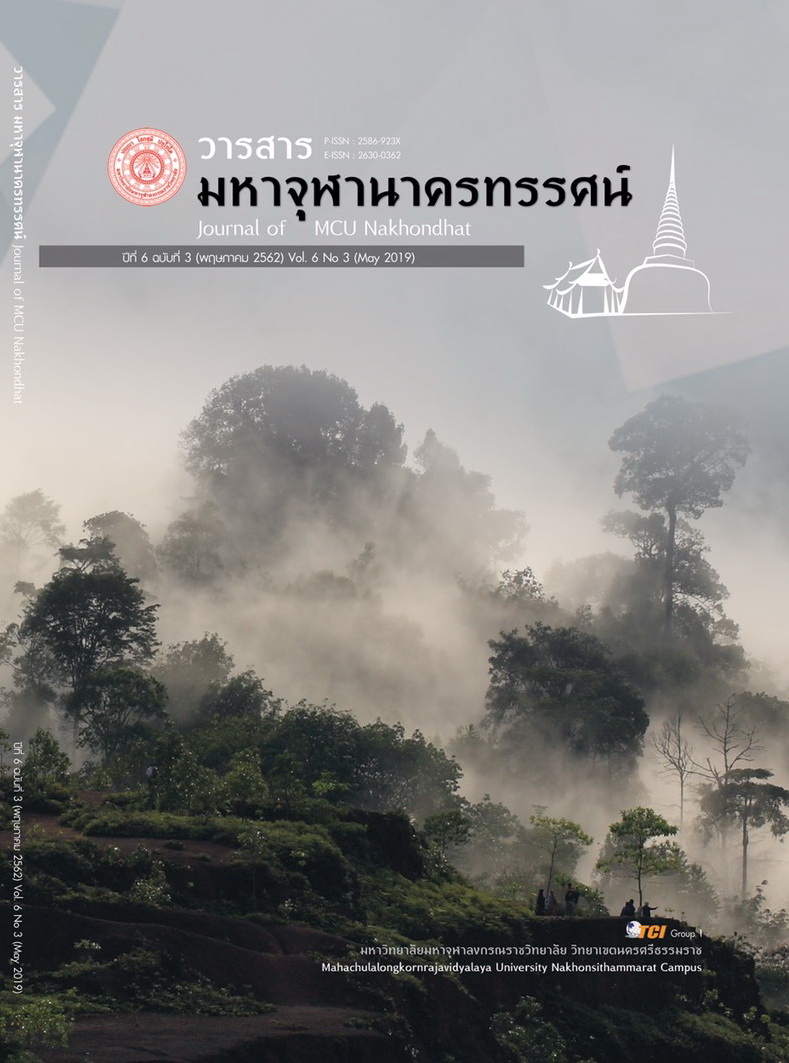THE FROMS AND PROSESSES OF MEDITATION TEACHING AT NAKHONSRITHAMARAT PROVINCE
Main Article Content
Abstract
The objectives of this research were: 1) to study the model and teaching process of Vipassana meditation in Buddhist scriptures, 2) to study problems and obstacles in teaching Vipassana meditation in Nakhon Si Thammarat Province, 3) to analyze patterns and methods of teaching Vipassana meditation in Nakhon Si Thammarat Province. This research is a qualitative research consisting of documentary research and in-depth interview by collecting participatory observation data and without participation, then analyzed and presented the research results by descriptive analysis.
The results showed that:
- The practice of Vipassana meditation, which appears in the Buddhist scriptures, has 2 types, namely Samatha meditation and Vipassana meditation. The most complete principle of practice is shown in "Mahasatipatthana Sutra", the pattern of the Mahasatipatthana Sutra is a rhetorical style of self-response and with metaphors mixed, and it is a perfect lecture process consisting of the section of explanation, the section of demonstration and the section of benefits. This is a lecture that is easy to understand and can follow correctly. The heart of the importance of the Sutra which the Lord Buddha mentioned is the Four Foundations of Mindfulness, consisting of 1) Kayanupassana satipatthana: mindfulness as regards the body, 2) Vedananupassana satipatthana: mindfulness as regards feelings, 3) Cittanupassana satipatthana: mindfulness as regards mental conditions, 4) Dhammanupassana satipatthana: mindfulness as regards ideas (mind-objects).
- Problems and obstacles in teaching Vipassana meditation in Nakhon Si Thammarat. There are many things that can be divided into two main things: the problems that arise from the teachers themselves, such as the lack of the ability to apply the principles to the current events, the teaching that is not in the same direction, Lack of good public relations that making Vipassana meditation practice in the group only. Another problem is the problem caused by the practitioner itself, such as the inability to cut external provocation, considered as an obstacle to the practice.
3. The method of practicing the Vipassana base of most meditation schools In Nakhon Si Thammarat Province. The school has applied new forms and teaching processes in some parts for easy and convenient practice. However, the main principle remains in the framework of the Four Foundations of Mindfulness with the objective of the most benefits for the practitioner to escape suffering, reach the results and attain the Nirvana. And for the present benefit is to purify the various behaviors both physical, Verbal and mental to be clear, calm and bright in three way: precepts, meditation and wisdom until able to control mental healing.
Article Details
References
พระธรรมปิฎก (ป.อ.ปยุตฺโต). (2543). พุทธธรรมฉบับปรับปรุงและขยายความ (พิมพ์ครั้งที่ 9). กรุงเทพมหานคร: มหาวิทยาลัยมหาจุฬาลงกรณราชวิทยาลัย.
มหาวิทยาลัยมหาจุฬาลงกรณราชวิทยาลัย. (2539). พระไตรปิฏกภาษาไทย ฉบับมหาวิทยาลัยมหาจุฬาลงกรณราชวิทยาลัย พุทธศักราช 2539. กรุงเทพมหานคร: มหาวิทยาลัยมหาจุฬาลงกรณราชวิทยาลัย.
มหาวิทยาลัยมหาจุฬาลงกรณราชวิทยาลัย. (2558). อรรถกถาธรรมบทภาค 1. กรุงเทพมหานคร: โรงพิมพ์มหาวิทยาลัยมหาจุฬาลงกรณราชวิทยาลัย.
ศูนย์ปฏิบัติวิปัสสนากัมมัฏฐาน วัดชายนา. (2554). คู่มือแม่ชี-เนกขัมมนารี (พิมพ์ครั้งที่ 3). นครศรีธรรมราช: โรงพิมพ์เม็ดทราย.


